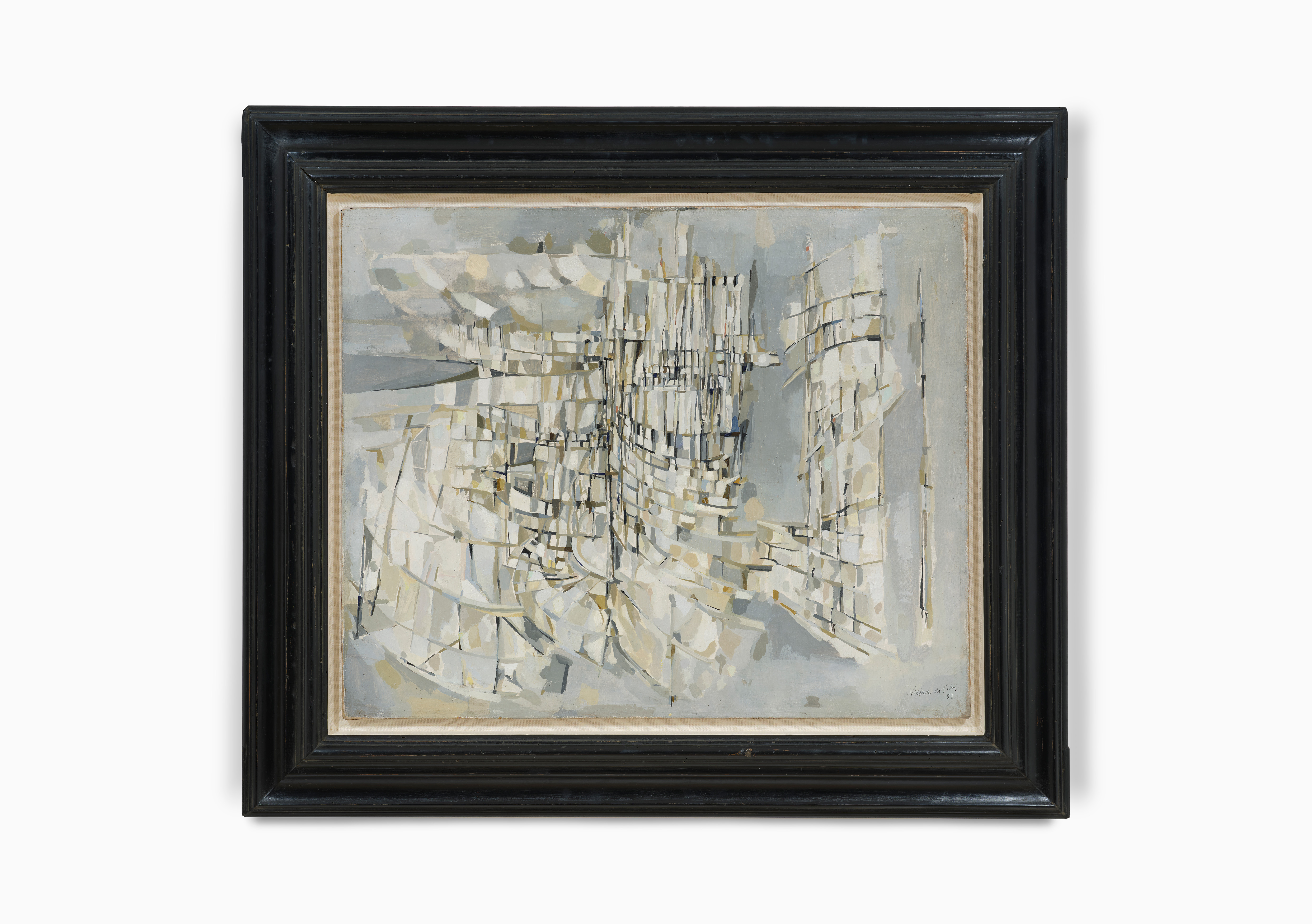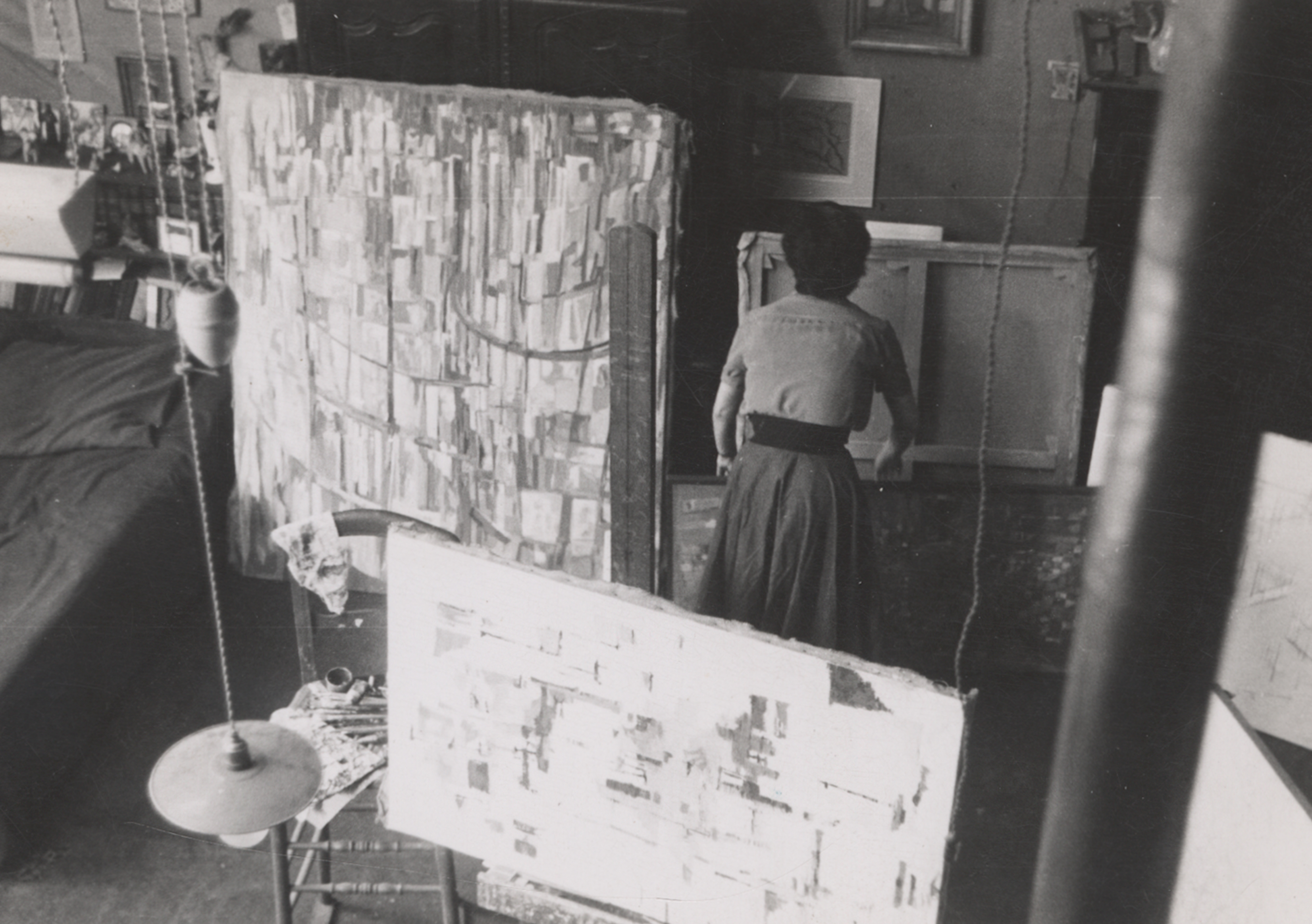Maria Helena Vieira da Silva (1908 -1992)
Les tours de verre, 1952
Oil on canvas
60 x 73 cm | 23 9/16 x 28 11/16 inch
Les tours de verre by Maria Helena Vieira da Silva and Grande Imanta by Alicia Penalba were created ten years apart. Through the fragmentation of lines and volumes, both works explore the concept of space and reveal the remarkable genius of these two major post-war artists.


Les tours de verre, 1952
Oil on canvas
60 x 73 cm | 23 9/16 x 28 11/16 inch
Grande Imanta, 1962
Bronze
104 x 120 x 52 cm | 40 15/16 x 47 3/16 x 20 7/16 inch
Les tours de verre embodies Vieira da Silva’s 1950s work and her significant period of urban landscapes. Blurring the lines between figuration and abstraction, her graphic construction carries an inner strength that structures the painting as a whole through the relentless crisscrossing of straight or broken black lines. A master of colour, Vieira highlights this complex arrangement with a brilliant use of different hues, lifting the apparent monotony of grey with touches of ochre, barium yellow, brown, and, here and there, cobalt blue or pale cyan, infusing the work with a striking luminosity.
Reminiscent of visited or imagined places, the pictorial space seems to deconstruct before our eyes, revealing the “spatial framework” evoked by art historian Diane Daval. With a distinctive verticality, it becomes evident through the structure of these two skyscrapers that emerge beneath grey facades, as if materialising from a fog. Multiplying the vanishing points, the artist unveils an almost dreamlike urban scene imbued with a poetic uncertainty that seems to permeate all her works.

M.H. Vieira da Silva in her workshop on boulevard Saint-Jacques, 1957 © Clarissa Dreyer © Willy Maywald © All rights reserved
Upon her return from Brazil in 1947, Vieira da Silva reconnected with the Parisian art scene and soon gained exposure through exhibitions in Paris and internationally. This marked the beginning of a new creative phase, during which the artist shifted from studies of interiors to confronting the city and its inextricable mazes.
The painter then unfolded a visual vocabulary driven by themes she would explore throughout her life: the notions of space and perspective, the city and urban constructions, as well as memory. These themes emerged during her years of exile, when she began to depict squares and streets, notably those of Lisbon. Vieira would develop these visual elements in the 1950s through urban panoramas with labyrinthine compositions, such as Les tours de verre.
Created a year later, her work Les tours stands as a counterpart to Les Tours de verre and highlights the significance of Vieira’s research on urban landscapes, particularly the towers that were evidently the subject of study in several of her works.
Displayed during her major retrospective “L’œil du labyrinthe” at the Dijon Museum and the Cantini Museum in Marseille, this oil on canvas now remains in the collection of the Grenoble Museum, while Les tours de verre was for a long time part of the prestigious collection assembled by Charles Zadok, a prominent American collector, alongside works by Derain, Miró, Léger, Kandinsky, and Picasso.
“What is admirable about Vieira da Silva's work is her own ability to evolve, to extricate herself from this core of extreme complexity.”
Florence Évrard et Isabelle Gozard
As Alicia Penalba’s sculptures gained increasing success, the 1960s saw the artist create more and more ambitious and imposing works in which she explored various themes related to nature and its metamorphosis, all directly inspired by her childhood, spent immersed in the Patagonian landscapes. Plants and rocks intertwine with the myths of her homeland, their forms transcended by bronze in a “musicalised nature, deliberately impoverished, reconstructed with few elements”, comments Michel Seuphor.
Grande Imanta first refers, in its title, to the notion of magnetism as well as the energy of the Earth, and to a mineral essence revealed by the different parts of the sculpture, which appear as rock fragments. They seem to concentrate around a central core that acts like a magnet, seemingly attracting and repelling them at the same time. A study on the origins of movement, the work adds a cerebral dimension to Penalba’s work and stands as a key piece in her reflection on sculptural space. The voids left by the gaps between the various parts of the bronze become channels of an invocative power that lays bare the internal dynamics of the world.
Penalba arrived in France in 1948 as a painter, soon to abandon the brush altogether in favour of sculpture. Her first abstract piece was produced around 1951-52. From then on, she too gained increasing visibility and quickly achieved worldwide recognition, attesting to the exceptional nature of her work.
The sculptor’s practice often served as a metaphor for her personal journey. She initially shaped her bronzes vertically, but by the late 1950s, the lines of force extended towards rather horizontal shapes as she flourished both in her art and in her new life in Paris. In the following decade, Penalba would dedicate herself to exploring space through various processes linked to the ideas of metamorphosis and the natural world, with Grande Imanta being one of its most powerful echoes.


Numbered 1/4, this sculpture is the very first of its series and was cast in 1962, along with four others and an artist’s proof, made by Susse Fondeur. Alicia Penalba worked closely with the foundry, which is now considered the oldest art foundry in France.
Another copy, numbered 3/4, is currently held at the Dallas Museum of Art in the United States. The sculpture was featured repeatedly in major exhibitions: at the 18th Salon des Réalités Nouvelles in 1963, in the travelling retrospective of the artist in the Netherlands between 1964 and 1965, at the Bonino Gallery in New York, at the Galerie d’Art Moderne and the Alice Pauli Gallery in Basel, as well as at the Musée d’Art Moderne de la Ville de Paris during the pivotal “Lam, Matta, Penalba. Totems and Tabous” exhibition in 1968.
“Intelligent and passionate, Penalba is unquestionably one of the most brilliant figures in contemporary sculpture in Paris.”
Michel Seuphor

Victoria Giraudo

Placed in dialogue, the two works reflect the numerous common features between the practices of both women, who, through different themes, inspirations, and methodologies, manage to deliver an artistic production of great visual proximity through, for instance, surprisingly similar structures. Victoria Giraudo, the exhibition curator, attributes this effect to their self-referential dimension, shaped by a shared experience of exile in particular, but also of solitude, from which result their profoundly existential works.
With Vieira, the lines drawn on the surface of the canvas seem as if in perpetual motion, endlessly intersecting within the frame of this “uncertainty” she often mentioned, which inhabited her and somehow guided the construction of her works entirely. Penalba, on the other hand, is driven by the idea of metamorphosis and instability. Two perspectives on life and art that ultimately appear really close, and which Les tours de verre and Grande Imanta fully embody.


Les tours de verre by Maria Helena Vieira da Silva and Grande Imanta by Alicia Penalba are two pivotal works of the historic exhibition “Vieira da Silva / Penalba. The Path to Consecration”.
At the heart of a dialogue between paintings and sculptures, these works, placed side by side, respond to each other, the former fully embodying Vieira’s 1950s period, the latter a fundamental milestone in the sculptor’s practice.